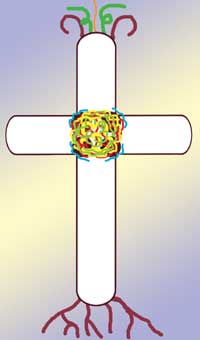Positive Health Online
Your Country

The Mind, Metaphor and Health
by Penny Tompkins and James Lawley(more info)
listed in mind matters, originally published in issue 78 - July 2002
The use of metaphor and symbol in the healing process stretches back thousands of years. These days, traditionally trained medical practitioners have made use of metaphor and imagery with patients with cancer and other illnesses.[1-3] A new process, Symbolic Modelling – comprehensively explained in our book, Metaphors in Mind: Transformation through Symbolic Modelling[4] – follows in this tradition.
This article explains why metaphor is a natural way to describe illness and health, the importance of recognizing patients'/clients' metaphors, and how working within these metaphors can activate an individual's personal healing process.
Metaphors Define Reality
For a long time metaphors were seen as 'merely figurative' and considered to be an inadequate way of describing experience. Today many cognitive scientists, linguists and philosophers recognize that "In all aspects of life… we define our reality in terms of metaphors and then proceed to act on the basis of the metaphors. We draw inferences, set goals, make commitments, and execute plans, all on the basis of how we in part structure our experience, consciously and unconsciously, by means of metaphor."[5] And as many health workers have discovered, metaphors can play a vital role in the healing process.
A Barren Snow-topped Mountain
A dermatologist who makes use of Symbolic Modelling, Dr Justina Cladatus, reports: "One of my patients had problems of alopecia areata (bald patches). His initial metaphor for his symptoms was a barren mountain with a white snow top. As the process unfolded he found himself tied to a wall by dark brown ropes in a dark, grey cement room with nothing but a little barred window. His metaphor evolved until he was standing beside a white well situated in a beautiful valley full of yellow flowers and green vegetation. The well was a source of refreshing water. In the meantime, the snow melted, and the mountain became a little hill with trees growing on it. And his hair has started to grow back."
Bunny Rabbits and Cancer Carrots
Peter Hettel was diagnosed with cancer of the sinus. Following surgery his cancer returned, and so he started working with imagery and symbol. Peter discovered that his white immune cells were like "bunny rabbits feasting on fields of orange cancer carrots, which increased their energy and sex drive, which made them have sex and make more bunnies who were also hungry to eat more." One morning he realized to his surprise that he couldn't find enough carrots for all his rabbits! A few weeks later he literally spat out his tumour. His doctor said, "It was like his body had rejected a foreign object, like a transplant rejection, just expelled from his body. I can't account for it."[6]

Metaphor in Health Consultations
A recent study of metaphoric expressions used by doctors and patients concludes that "If metaphors are indeed the embodiment of experience, rather than, or as well as, surface analogies for the sake of lucidity, an understanding of metaphor is as important for doctors as it is an understanding of patient health beliefs."[7] True as this might be, after recording 373 consultations of 39 GPs, the study found that while "there were no significant differences between the doctors and their use of particular metaphors… there were some clear distinctions between doctor and patient metaphors". Doctors tended to use metaphors that assume the body is a machine (the urinary tract was the 'waterworks', bodies could be 'repaired', joints suffer 'wear and tear'); illness is a puzzle (symptoms are 'clues' to 'problems' that have to be 'solved'); and a doctor is a controller (they 'administer' medication to 'manage' symptoms and 'control' disease).
Patient metaphors, on the other hand, were more vivid, expressive and idiosyncratic (It's "like Satan's got into her", "I'm the cotton wool man", It's "like a Chinese burn, it just gets tighter and tighter", It's "as though my body has been pummelled").
Even when doctors and patients used the same words (such as 'tension', 'relaxation', 'nerves') doctors tended to use them literally while patients used them metaphorically. Patients used metaphors such as 'dull', 'stabbing' and 'sharp' to describe aches and pains, but these words were never used by the doctors taking part in this study.
Apart from the few metaphors used equally by doctors and patients – illness is an attack (heart, asthma and panic 'attacks', 'fight' infection, 'painkillers') and illness is fire ('burning' pain, 'inflamed' condition, symptoms 'flaring up') – we can conclude that doctors and their patients talk different languages. No wonder that so many patients do not feel heard, and that errors of communication occur. An Institute of Medicine report on medical errors estimates that in the USA "between 44,000 and 98,000 hospital patients die each year from preventable medical errors… that more people die each year from errors than from breast cancer or motor vehicle accidents; more than half of those deaths are preventable… Errors result from prescribing mishaps, communication gaps and a distracted staff."[8]
If health workers were trained to recognize patient metaphors, to accept them as an accurate description of the illness, and were aware of their own use of metaphor, then those 'communication gaps' could be considerably reduced. As Margaret Lock in Uncommon Wisdom says, "In the healing process the most important part of communication takes place at the metaphoric level. Therefore you have to have shared metaphors."[9]
Symptom Description
The British Journal of General Practice study shows how often patients spontaneously use metaphor to describe their symptoms (965 different metaphors were identified).[7] Sometimes, however, they need to be invited to use such language. While giving a Healthy Language course for a group of nurses who specialized in multiple sclerosis, we were told that their patients often had difficulty describing the bizarre nature of their symptoms. We suggested that they ask them, "And when it's difficult to describe your symptoms, those symptoms are like what?" This question acknowledges the patient's difficulty, and then invites them to use metaphor to describe the qualities and characteristics of their subjective experience of their illness.
When the nurses asked this question, they got responses such as "It's like ants running all over my body" and "It's like cheese wire wrapped round my legs". Further questions, such as "And is there anything else about that [patient's metaphor]?" or "And what kind of [patient's metaphor] is that?", encouraged the patients to describe their strange sensations in greater detail. The nurses were surprised at just how relieved the patients felt when they could explain their symptoms in this way. Some patients said it was the first time they felt that someone had really understood what it was like to experience their illness.
Symbolic Modelling
In addition to using metaphors to describe symptoms, clients can benefit from having metaphors for their illness developed and evolved into metaphors for health. Hejmadi and Lyall maintain that the use of autogenic (self-generated) metaphor can be particularly useful in "functional or stress-related illnesses, those in which no specific micro-organism has been identified as the source of physiological breakdown. This category of dysfunction includes such major catastrophic health problems as cardiovascular disease, some forms of cancer, and the so-called auto-immune diseases, as well as those which are less catastrophic, such as gastric ulcer, many allergic conditions, myofacial pain syndromes, migraine, and PMS. It is estimated that 50 to 80 per cent of all physical illnesses requiring medical attention are stress-related or functional in nature."[10]
When developing client-generated metaphors for healing we have found it particularly important to use 'clean' language. This means we do not 'contaminate' the client's experience with our personal preferences for certain types of metaphor or figures of speech. Symbolic Modelling is expressly designed to work in this way.[11]
There are three features that distinguish Symbolic Modelling from other processes that use metaphor and visualization:
1. Its reliance on the client, and only the client, to identify and evolve their own metaphors for illness and health;
2. A particular way of asking questions of their metaphors, called 'Clean Language' and originated by David Grove;[12]
3. While metaphors are commonly expressed as images, Symbolic Modelling also makes use of feelings, gestures, sounds, drawings, physical objects, etc.
Through Symbolic Modelling, the conflict, imbalance, or dis-ease inherent in the client's metaphor finds its resolution in unexpected and organic ways. When this happens, the individual usually experiences a corresponding change in their symptoms; sometimes immediately, and sometimes in the following days or weeks. Here is an example.
Case Study: From Cross to Willow
This account was written by a participant on a workshop which used a combination of Symbolic Modelling and Pilates to work with participants' physical symptoms.[13]
"I had pain in my upper back that had started a year before I finished writing my book. I so wanted to finish the book I used my will to keep working, even though my back was worsening.
"The first Clean Language question I was asked was: 'And what would you like to have happen?' I replied I wanted to be free of this bloody pain so I could be comfortable while wearing a shoulder-strap handbag again. I was asked questions that helped me get clear about my symptoms, and then I was asked 'And that "tightening, grinding, abrasive back pain" is like what?' I replied 'It's like I have a cross on the inside of my body. My spine is the long part of the cross, and the crossbar goes through my shoulders.' In describing this metaphor, words, pictures and movements came naturally, unbidden by me. As I became engaged with my metaphor, I realized 'It's not the cross that's the problem, but the crossbar is bolted on with four huge metal bolts. There is no flexibility at all. Every time I move against one bolt, they all are put under strain and hurt.' At this point the symbols ceased to be symbolic – they took over my reality! [Figure 1.]

Figure 1
"Q: 'And what kind of cross is that cross inside your body?'
Me: 'It's a wooden cross.'
Q: 'And is there anything else about those four huge metal bolts?'
Me: 'They refuse to move.'
Q: 'And when there's a wooden cross and four huge metal bolts that refuse to move, what would that cross like to have happen?'
Me: 'It needs to be willing to be flexible yet grounded.'
Q: 'And can it be willing to be flexible yet grounded?'
Me: 'No, the bolts won't let it.'
Q: 'And what would bolts like to have happen when they won't let it?'
Me: 'They need colour and support before they can let go.'
"After more questions, and more insights, I was asked to draw a picture of my metaphor, and to use a dictionary to look up some of the words I had used (e.g. cross, refuse, bolt).
"When I considered the word 're-fuse' I realized it had an electrical connotation, and a mass of multi-coloured electrical wires suddenly appeared between the four huge bolts. I added this new image to my drawing [Figure 2]. I then did gentle Pilates exercises, all the while focusing my attention on my metaphor.

Figure 2
"The next day more Clean Language questions were asked, and more developing of the metaphor resulted, until at some point I leaned forward in my chair. When I came back up, the most amazing thing happened. I could feel the bolts in the cross releasing. It felt like 'ping-ping-ping' and I just sat, aware that change was happening in the moment. When the 'ping-ing' stopped, my back pain was gone. I thought we were finished. But thankfully the questions continued because they helped me become aware of the effects of the change. The crossbar was now attached by rubber bands wrapped around it at all angles. This meant that as I moved, the crossbar was flexible and could move with me. [Figure 3]

Figure 3
"Q: 'And as rubber bands wrap around at all angles, what happens to the cross?'
Me: 'It's becoming heavy on the bottom.'
Q: 'And as it becomes heavy on the bottom, then what happens?'
Me: 'It's growing roots.'
Q: 'And as it's growing roots, then what happens?'
Me: 'Up-and-over branches are beginning to sprout from the top.'
"This continued until I had a full, embodied sense of my cross turning into a willow tree, with electrical wires beautifully woven through the trunk – flexible, stable, graceful and strong. Every question increased my bodily awareness of this change. [Figure 4.]

Figure 4
"Since this workshop I have had a few twinges in my back, but these disappeared as I focused my attention on my willow tree and did my Pilates exercises. I still have my willow (will-o!) and, yes, I carry a shoulder-strap bag, and wonder of wonders, I can even wear a backpack!"
Conclusion
Metaphor and symbol are natural ways to describe symptoms and health. There is a great benefit for health-care professionals to learn how to recognize the metaphors people use, how to work within these metaphors, and how doing so can influence healing and well-being.
Metaphors used by patients and clients may be idiosyncratic but they are not random. They contain an organization that represents the mind-body system that produced them. Through identifying, developing and evolving client-generated metaphors with Symbolic Modelling and Clean Language questions, information is revealed and organic healing can take place.
No matter what type of health worker you are – GP, consultant, bodyworker, psychotherapist, or complementary medicine practitioner – your clients and patients will use metaphor and symbol to describe their subjective experience. We encourage you to listen to, and to ask clean questions of these metaphors and symbols. Then simply notice the results.
Further Information
For information on their work, their forthcoming training courses and over 50 articles, visit www.cleanlanguage.co.uk
References
1. Shealy CN and Myss CM. The Creation of Health. Stillpoint. Walpole, NH. 1988.
2. Siegel BS. Love, Medicine & Miracles. Harper & Row. New York. 1990.
3. Simonton OC, Mathews-Simonton S and Creighton JL. Getting Well Again. Bantam. London. 1986.
4. Lawley J and Tompkins P. Metaphors in Mind: Transformation through Symbolic Meaning. The Developing Company Press. ISBN 0-9538751-0-5. 2000. Can be ordered from Positive Health.
5. Lakoff G and Johnson M. Metaphors We Live By. University of Chicago Press. p158. 1980.
6. Hirshberg C and Barasch MI. Remarkable Recovery. Headline. London. pp287-93. 1996.
7. Skelton JR et al. A concordance-based study of metaphoric expressions used by general practitioners and patients in consultation. The British Journal of General Practice. 52(475): 114-18. 2002.
8. Cohen MR et al. How to prevent medication errors. Journal of American Academy of Physician Assistants. 14(11): 47-55. 2001.
9. Capra F. Uncommon Wisdom: Conversations with Remarkable People. Bantam. New York. p289. 1989.
10. Hejmadi AV and Lyall PJ. Autogenic metaphor resolution. in Bretto C et al eds. Leaves Before the Wind. Grinder, DeLozier & Associates. Bonny Doon, CA. 1991.
11. When using Symbolic Modelling with the physical manifestation of symptoms, we always recommend that clients continue to seek advice from their medical practitioner.
12. The full list of Clean Language questions is available on our website: www.cleanlanguage.co.uk
13. The workshop leaders were Caitlin Walker and Catherine Saeed. See: www.trainingattention.co.uk
Comments:
-
No Article Comments available